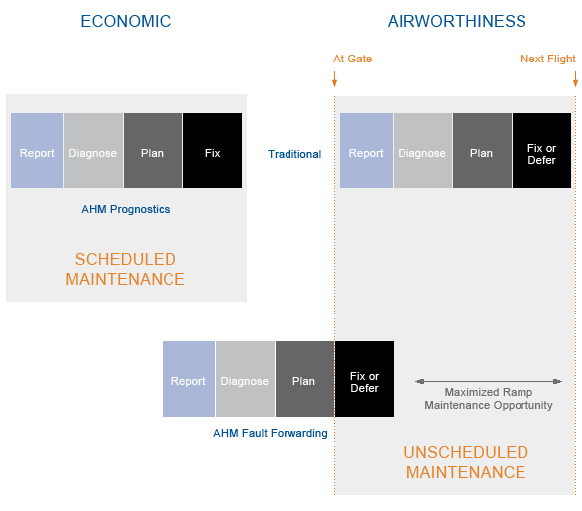
BENEFITS
AHM is designed to deliver airplane data when and where it’s needed, allowing operators to make informed operational decisions quickly and effectively. The primary benefit provided by AHM is the opportunity to substantially reduce schedule interruption costs. Schedule interruptions consist of delays, cancellations, air turnbacks, and diversions. The three primary ways that AHM reduces schedule interruptions are prognostics, fault forwarding, and prioritization.
Prognostics. AHM helps operators forecast and address conditions before failure, a process referred to as “prognostics.” With AHM, operators can identify precursors that are likely to progress to FDE faults, which will affect airplane dispatch and possibly cause schedule interruptions. AHM provides an operator’s engineers with the information they need to make sound economic decisions regarding these precursors, so that the operator can perform maintenance on monitored faults on a planned basis, rather than having to react to unexpected problems with unplanned maintenance.
Fault forwarding. When a fault occurs in-flight, AHM allows the operator to make operational decisions immediately, and if maintenance is required, to make arrangements for the people, parts, and equipment sooner rather than later. This enables operators to substantially reduce the number of delays (e.g., a delay is prevented altogether) and the length of delays (e.g., a three-hour delay is shortened to one hour — see fig. 2). AHM provides both the information and the context to enable operators to make appropriate decisions while the airplane is still en route.
Figure 2
AHM enables operators to report and diagnose faults and plan for repairs before the airplane even reaches the gate, maximizing the ramp maintenance opportunity. This deals with conditions which affect airworthiness (i.e., affect next release), and which typically take place in an unscheduled manner. In addition, condition monitoring allows for purely economic conditions to be considered and resolved, thus allowing them to be addressed in a scheduled manner, and reducing in-service interruptions.

Prioritization. Information about fuel efficiency, economic impacts, and other performance factors is provided according to its importance to the operator, allowing the operator to determine the best course of action.
A number of secondary benefits result from the reduced schedule interruptions realized by using AHM:
Reduced down-line disruptions. AHM can be used by operators to calculate the likelihood of down-line disruptions and estimate the cost of such disruptions.
Reduction of missed Air Traffic Control slots. AHM can help operators reduce missed Air Traffic Control slots that result from technical delays.
Improved supply chain efficiencies. With AHM prognostics, operators can better predict line-replaceable unit failures, which means fewer cases of unscheduled removals. That results in fewer parts being borrowed and fewer parts being prepositioned at remote stations.
Reduced no fault found (NFF). AHM reduces the likelihood of NFF, which in turn reduces labor and spares requirements.
RECENT AHM ENHANCEMENTS
AHM has recently been enhanced to provide an even greater amount and depth of information. Called the "parametric module," these enhancements comprise four primary components.
Systems condition monitoring. AHM uses available parametric data to assess the condition of airplane systems. It collects airplane system data using existing and new ACMS reports and compares system performance against system models.
Servicing management. By gathering data on monitored systems — including auxilliary power unit oil, engine oil, oxygen, tire pressure, and hydraulic fluid levels — AHM can provide alerts on system conditions approaching operational limits. This data-based remote condition monitoring identifies airplanes requiring system maintenance to enable replenishment prior to exceeding operational limits.
Airplane performance monitoring (APM). AHM calculates airplane performance using the ACMS APM/engine stable reports and allows operators to compare airplanes through a fleet summary view. It also integrates engine health monitoring alerts, displaying engine manufacturer (OEM) alerts of abnormal conditions and automatically linking to the engine OEM system.
ACMS report viewer and data extractor. AHM incorporates an enhanced means for viewing and analyzing ACMS data.

